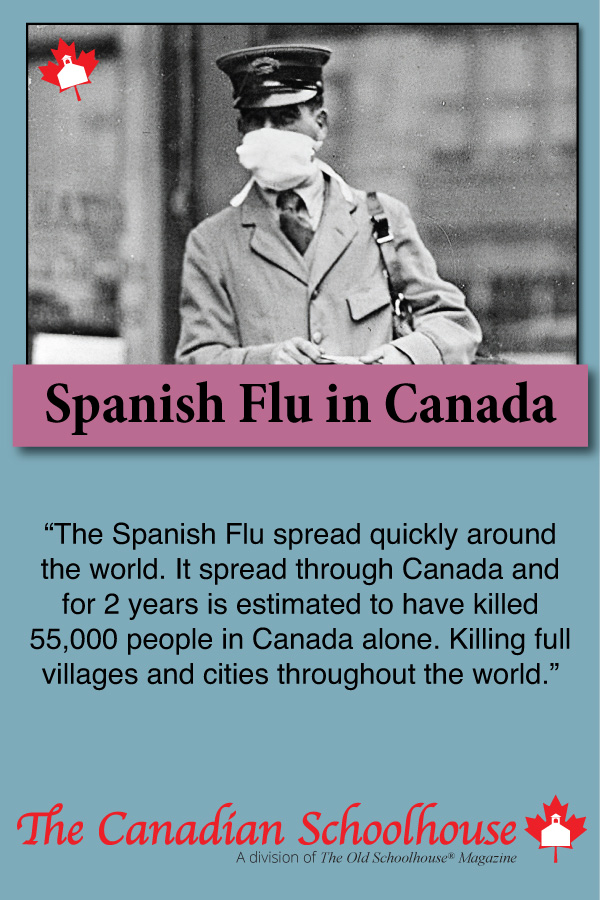
Pandemics have been happening around the world since the beginning of time. Many have wiped out cities and villages quickly. From the bubonic plague to the coronavirus, we have learned that pandemics can pop up and infiltrate a population quickly. One pandemic that hit Canada was the Spanish flu from 1918 to 1920. The Spanish flu spread quickly around the world. It spread through Canada and for two years is estimated to have killed 55,000 people in Canada alone. Killing full villages and cities throughout the world.
What was the Spanish Flu?
The Spanish flu was a mutated form of influenza. The typical flu symptoms led to pneumonia, and unlike the typical flu, it affected the young adult population more than those with impaired immune systems. The Spanish flu is now more commonly known as H1N1
Where did it start?
One would think the Spanish flu started in Spain as the name suggests, but it is actually unknown where it originated. The Spanish flu was named such because of the media censorship of Allied countries during World War I. The Allied countries chose to suppress the death toll to hide the death counts happening during the war. Because Spain had stayed neutral during the war, their death tolls were reported, and the spike of deaths was apparent. Because of these reports, it was associated with Spain and named the Spanish Flu.
Why did it spread?
During World War I, soldiers began to spread the Spanish flu. Because it was highly contagious, it was quick to spread between those soldiers fighting in the first world war. As the troops began to return home from the war, the spread continued throughout their hometowns and eventually throughout the countries.
With no vaccine or treatment, it spread quickly.
Because it affected young, healthy adults, it spread through hospital staffs, and soon the number of people available to take care of patients dwindled.
To fill the void, volunteers risked their own lives trying to help those in need. These were not ideal situations, and due to the multiple waves of the virus over the next two years, it was hard to get it under control.
What was the impact of the Spanish Flu in Canada?
The 1918 flu killed an estimated 55,000 Canadians and, in some cases, entire villages. Families were left without their typical family dynamic, and many children were left parentless.
The loss of the working parent led to an economic fall and impacted the entire country. Because of the Spanish flu, the work force became considerably less. With the economic downturn, families could not afford to buy products that were not necessities which in turn led to businesses with product they could not sell.
At one point, war celebrations that should have been postponed were celebrated, leading to more deaths.
Due to the way the Spanish flu pandemic was handled in Canada, the government decided to develop the Department of Health in 1919. The Department of Health in Canada created a way to share the responsibility of health through all levels of government.

How is it similar to coronavirus of 2020?
Coronavirus (COVID-19) and the Spanish flu have been found to be similar in many ways.
The spread of the virus through travel is the most apparent comparison. Both viruses were spread quickly by travel. The Spanish flu spread by boat and train during the war, while the coronavirus spread by airplanes. This led to the viruses being spread from country to country and continent to continent.
The other comparison that can be made is the spread due to the lack of immunity. This also played a part in both viruses. Because of the lack of immunity in the population, the viruses spread quickly.
How was the Spanish flu different from coronavirus?
While the two are very similar, there is a major difference between the two. This difference is in regards to the population the viruses affected. The Spanish flu affected young, healthy adults while coronavirus has affected those with immunity impairment and the elderly.
Learning from the past helps us to grow and become smarter about the decisions we make in times of crisis. The Spanish flu has taught us many things about the way pandemics can spread and what issues may arise, and it will continue to impact the way we handle pandemics that arise in the future as well. A pandemic can happen anytime and anywhere. The more prepared we are the better, and the past is a great way to make changes and adapt to the issues at hand.
This article has been written by homeschooling staff writers of The Canadian Schoolhouse (TCS). Enjoy more of our content from TCS contributors and staff writers by visiting our Front Door page that has content on our monthly theme and links to all our content sections.























